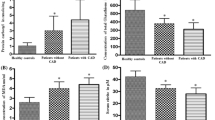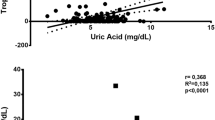Abstract
We have examined a possibility whether or not severity and extent of coronary atherosclerosis may associate with degree of local inflammation in relation to endothelial dysfunction as is indicated by reduced NO formation. Blood samples were obtained from aortic root (Ao) and coronary sinus (CS) of 39 patients who underwent coronary angiography. Plasma NOx levels (nitrite + nitrate, stable NO end-products) were evaluated by HPLC-Griess system, and markers of inflammation, C-reactive protein (CRP) and serum amyloid A protein (SAA), were measured by Latex Turbidimetric Immunoassay. To evaluate the changes of these substances through coronary circulation, the percentage changes of respective markers [(CS – Ao) × 100/Ao] were calculated. The extent and severity of atherosclerosis of left coronary arteries were evaluated with Gensini Score (GS). The GS correlated with the percentage changes of NOx (r = −0.35, p < 0.05) and that of SAA (r = 0.43, p < 0.05) across coronary circulation, but not with changes in CRP. Moreover, the percentage changes of NOx correlated with that of SAA (r = −0.36, p < 0.05). These results indicated that severity and extent of coronary atherosclerosis related to degree of local inflammation which has a possible association with coronary endothelial dysfunction.
Similar content being viewed by others
References
Suwaidi JA, Hamasaki S, Higano ST, Nishimura RA, Holmes DR Jr, Lerman A: Long-term follow-up of patients with mild coronary artery disease and endothelial dysfunction. Circulation 101: 948-954, 2000
Schächinger V, Britten MB, Zeiher AM: Prognostic impact of coronary vasodilator dysfunction on adverse long-term outcome of coronary heart disease. Circulation 101: 1899-1906, 2000
Liuzzo G, Biasucci LM, Gallimore JR, Grillo RL, Rebuzzi AG, Pepys MB, Masari A: The prognostic value of C-reactive protein and serum amyloid A protein in severe unstable angina. N Engl J Med 331: 417-424, 1994
Morrow DA, Rifai N, Antman EM, Weiner DL, McCabe CH, Cannon CP, Braunwald E: Serum amyloid A predicts early mortality in acute coronary syndromes: A TIMI 11 A substudy. J Am Coll Cardiol 35: 358-362, 2000
Biasucci LM, Liuzzo G, Grillo RL, Caligiuri G, Rebuzzi AG, Buffon A, Summaria F, Ginnetti F, Fadda G, Maseri A: Elevated levels of C-reactive protein at discharge in patients with unstable angina predict recurrent instability. Circulation 99: 855-860, 1999
Ridker PM, Cushman M, Stampfer MJ, Tracy RP, Hennekens CH: Inflammation, aspirin, and the risk of cardiovascular disease in apparently healthy men. N Engl J Med 336: 973-979, 1997
Ridker PM, Hennekens CH, Buring JE, Rifai N: C-reactive protein and other markers of inflammation in the prediction of cardiovascular disease in women. N Engl J Med 342: 836-843, 2000
Umans JG, Levi R: Nitric oxide in the regulation of blood flow and arterial pressure. Annu Rev Physiol 57: 771-790, 1995
Node K, Kitakaze M, Yoshikawa H, Kosaka H, Hori M: Reduced plasma concentrations of nitrogen oxide in individuals with essential hypertension. Hypertension 30: 405-408, 1997
Quyyumi AA, Dakak N, Mulcahy D, Andrews NP, Husain S, Panza JA, Cannon RO III: Nitric oxide activity in the atherosclerotic human coronary circulation. J Am Coll Cardiol 29: 308-317, 1997
Ramesh G, Varma JS, Ganguly NK, Dhawan V, Bali HK, Singh M: J Mol Cell Cardiol 31: 1495-1500, 1999
Ishibashi T, Matsubara T, Ida T, Hori T, Yamazoe M, Aizawa Y, Yoshida J, Nishio M: Negative NO3 − difference in human coronary circulation with severe atherosclerotic stenosis. Life Sci 66: 173-184, 2000
Hori T, Matsubara T, Ishibashi T, Yamazoe M, Ida T, Higuchi K, Takemoto M, Ochiai Y, Tamura Y, Aizawa Y, Nishio M: Decrease of nitric oxide end-products during coronary circulation reflects elevated basal coronary artery tone in patients with vasospastic angina. Jpn Heart J 41: 583-595, 2000
Gensini GG: A more meaningful scoring system for determining the severity of coronary heart disease. Am J Cardiol 51: 606, 1983
Ishibashi T, Kubota K, Himeno M, Matsubara T, Hori T, Ozaki K, Yamazoe M, Aizawa Y, Yoshida J, Nishio M: Respiratory alkalosis does not alter NOx concentrations in human plasma and erythrocytes. Am J Physiol 281: H2757-H2761, 2001
Hoffmeister A, Rothenbacher D, Bäzner U, Fröhlich M, Brenner H, Hombach V, Koenig W: Role of novel markers of inflammation in patients with stable coronary heart disease. Am J Cardiol 87: 262-266, 2001
Rifai N, Joubran R, Yu H, Asmi M, Jouma M: Inflammatory markers in men with angiographically documented coronary heart disease. Clin Chem 45: 1967-1973, 1999
Hojo Y, Ikeda U, Katsuki T, Mizuno O, Fukazawa H, Kurosaki H et al.: Interleukin-6 expression in coronary circulation after coronary angioplasty as a risk factor for restenosis. Heart 84: 83-87, 2000
Deliargyris EN, Raymond RJ, Theoharides TC, Boucher WS, Tate DA, Dehmer GJ: Sites of interleukin-6 release in patients with acute coronary syndromes and in patients with congestive heart failure. Am J Cardiol 86: 913-918, 2000
Torzewski J, Torzewski M, Bowyer DE, Fröhlich M, Koenig W, Waltenberger J, Fitzsimmons C, Hombach V: C-reactive protein frequently colocalizes with the terminal complement complex in the intima of early atherosclerotic lesions of human coronary arteries. Arterioscler Thromb Vasc Biol 18: 1386-1392, 1998
Yasojima K, Schwab C, McGeer EG, McGeer PL: Generation of C-reactive protein and complement components in atherosclerotic plaques. Am J Pathol 158: 1039-1051, 2001
Meek RL, Urieli-Shoval S, Benditt EP: Expression of apolipoprotein serum amyloid A mRNA in human atherosclerotic lesions and cultured vascular cells: Implications for serum amyloid A function. Proc Natl Acad Sci USA 91: 3186-3190, 1994
Artl A, Marsche G, Lestavel S, Sattler W, Malle E: Role of serum amyloid A during metabolism of acute-phase HDL by macrophages. Arterioscler Thromb Vasc Biol 20: 763-772, 2000
Esaki T, Hayashi T, Muto E, Yamada K, Kazuya M, Iguchi A: Expression of inducible nitric oxide synthase in T lymphocytes and macrophages of cholesterol-fed rabbits. Atherosclerosis 128: 439-446, 1997
Ishibashi T, Himeno M, Kubota K, Matsubara T, Hori T, Ozaki K, Yamazoe M, Aizawa Y, Yoshida J, Nishio M: Decrease in plasma NOx concentration by isosorbide dinitrate, an organic nitrate ester. J Cardiovasc Pharmacol (in press)
Maejima K, Himeno M, Ishibashi T, Nakano S, Nishio M, Uchida K: Paradoxical decrease in plasma NOx by L-arginine load in diabetic and non-diabetic subjects. Clin Exp Hypertension 24: 155-167, 2002
Keaney JF, Vita JA: Atherosclerosis, oxidative stress, and antioxidant protection in endothelium-derived relaxing factor action. Prog Cardiovasv Dis 38: 129-154, 1995
Beckman JS: Oxidative damage and tyrosine nitration from per-oxynitrate. Chem Res Toxicol 9: 836-844, 1996
Author information
Authors and Affiliations
Rights and permissions
About this article
Cite this article
Matsubara, T., Ishibashi, T., Hori, T. et al. Association between coronary endothelial dysfunction and local inflammation of atherosclerotic coronary arteries. Mol Cell Biochem 249, 67–73 (2003). https://doi.org/10.1023/A:1024778421491
Issue Date:
DOI: https://doi.org/10.1023/A:1024778421491




